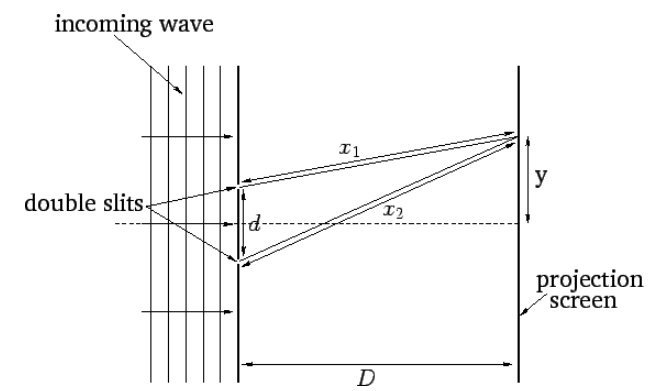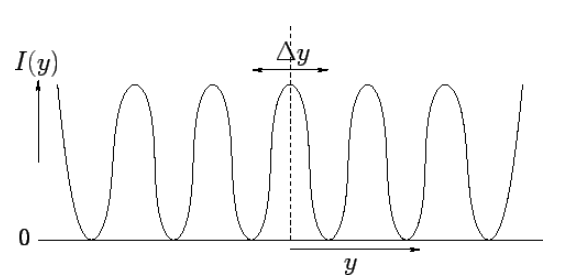2.7: Classical Interferences of Light Waves
( \newcommand{\kernel}{\mathrm{null}\,}\)
Let us now consider the classical interference of light-waves. Figure [f2] shows a standard double-slit interference experiment in which monochromatic plane light-waves are normally incident on two narrow parallel slits that are situated a distance d apart. The light from the two slits is projected onto a screen a distance D behind them, where D≫d.

Figure 5: Classical double-slit interference of light.
Consider some point on the screen that is located a distance y from the centre-line, as shown in the figure. Light from the first slit travels a distance x1 to get to this point, whereas light from the second slit travels a slightly different distance x2. It is easily demonstrated that
Δx=x2−x1≃dDy, provided d≪D. It follows from Equation (2.4.1), and the well-known fact that light-waves are superposible, that the wavefunction at the point in question can be written
ψ(y,t)∝ψ1(t)eikx1+ψ2(t)eikx2, where ψ1 and ψ2 are the wavefunctions at the first and second slits, respectively. However,
ψ1=ψ2, because the two slits are assumed to be illuminated by in-phase light-waves of equal amplitude. (Note that we are ignoring the difference in amplitude of the waves from the two slits at the screen, due to the slight difference between x1 and x2, compared to the difference in their phases. This is reasonable provided D≫λ. ) The intensity (that is, the energy flux) of the light at some point on the projection screen is approximately equal to the energy density of the light at this point times the velocity of light (provided that y≪D). Hence, it follows from Equation (2.4.11) that the light intensity on the screen a distance y from the center-line is
Using Equations (2.7.1)–(2.7.4), we obtain
Figure [f3] shows the characteristic interference pattern corresponding to the previous expression. This pattern consists of equally-spaced light and dark bands of characteristic width

Contributors and Attributions
Richard Fitzpatrick (Professor of Physics, The University of Texas at Austin)

